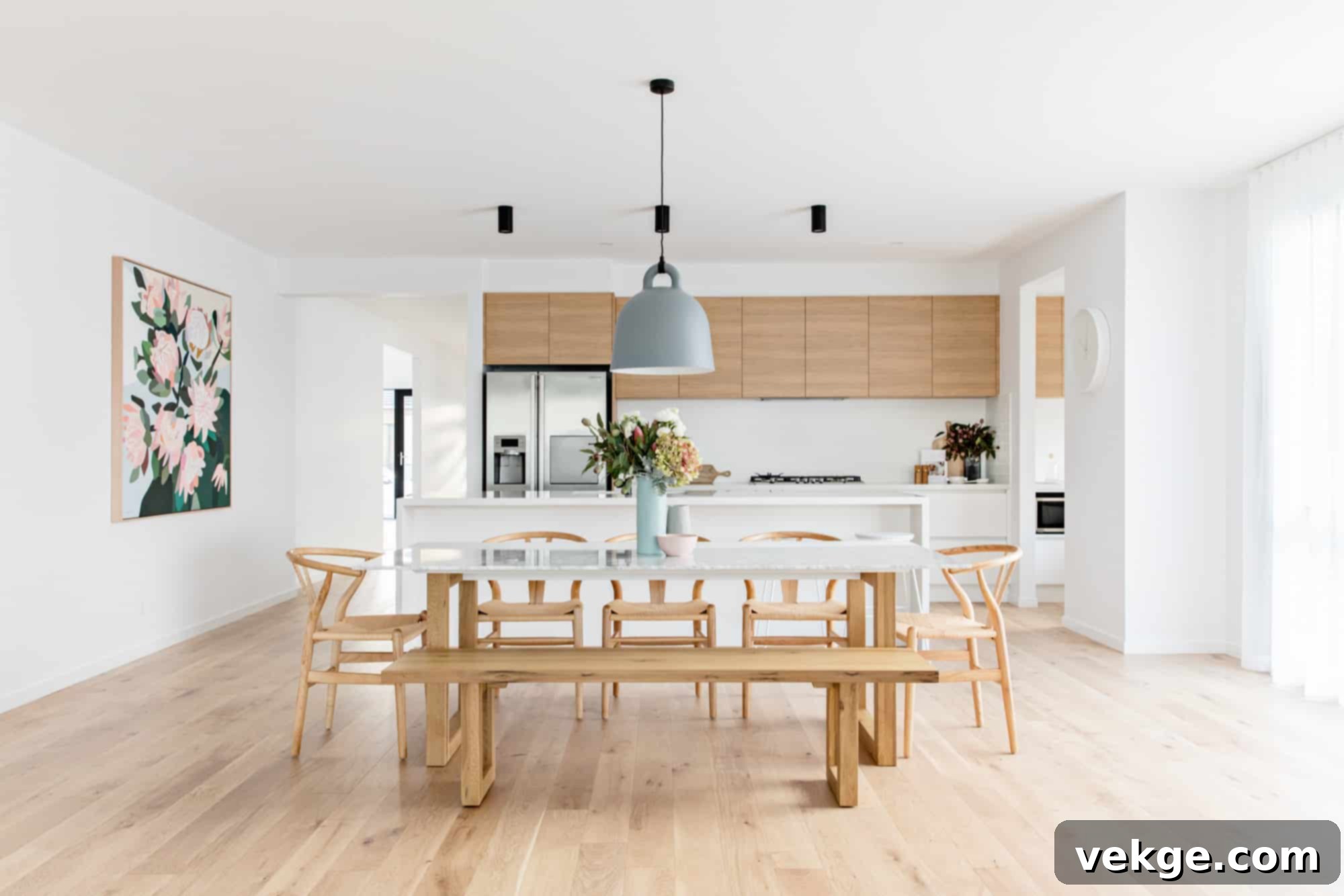Embrace Serenity: The Ultimate Guide to Scandinavian Dining Room Design (Pros & Cons)
The dining room serves as the heart of many homes, a sacred space where families gather to share meals, laughter, and stories. It’s more than just a place to eat; it’s where connections are forged and memories are made. Therefore, cultivating a comfortable, inviting, and functional atmosphere in this room is paramount. In recent years, Scandinavian decor has surged in popularity, captivating homeowners with its unique blend of simplicity, enduring style, and intelligent functionality. This design philosophy, rooted in the Nordic countries, offers a refreshing approach to interior design that prioritizes natural light, minimalist aesthetics, and practical living.
Opting for a Scandinavian dining room design means embracing a clean, sophisticated, and inherently timeless look. These spaces are often characterized by their minimalistic approach, a predominant use of neutral tones, subtle touches of natural wood, and well-chosen contrasting colors. Beyond aesthetics, Scandinavian designs are celebrated for their user-friendliness, making them surprisingly easy to set up and integrate into diverse living environments.
However, while the appeal of Scandinavian design is broad, it may not perfectly align with everyone’s personal taste or lifestyle. Before committing to this elegant yet understated style for your dining area, it’s wise to consider both its advantages and disadvantages. Let’s delve into the specific pros and cons to help you determine if a Scandinavian dining room is the right fit for your home.
Pros of a Scandinavian Dining Room
Scandinavian dining rooms are renowned for their ability to evoke a cozy, welcoming feel while maintaining an aesthetic that is both elegant and highly functional. They frequently feature robust furniture crafted from natural materials like wood or steel, set against a backdrop of soothing neutral palettes. Strategic placement of green plants and natural elements further enlivens the space, bringing a touch of the outdoors in. Below, we explore the key benefits that make this design style so desirable.
1. A Calming and Harmonious Dining Space
One of the most compelling aspects of a Scandinavian dining room is its profound sense of calm. Tables and chairs are typically constructed from natural materials such as light-toned wood (like birch, ash, or pine) or sleek, minimalist steel, and their designs are deliberately simple, clean-lined, and devoid of excessive ornamentation. The focus is on natural textures and organic forms that soothe the eye. Soft cushions on chairs and benches enhance comfort, inviting guests to linger longer. The overall color scheme revolves around neutral tones – whites, greys, beige, and muted blues or greens – which create an airy, expansive feel. Coupled with ample natural ventilation and light, these elements contribute to an environment that feels inherently restorative. To further amplify this natural ambiance, designers often incorporate lush green plants, handcrafted ceramic or earthen pottery, and minimal, abstract paintings or prints. These thoughtful touches collectively transform the dining area into a tranquil sanctuary, offering a peaceful retreat after a demanding day.
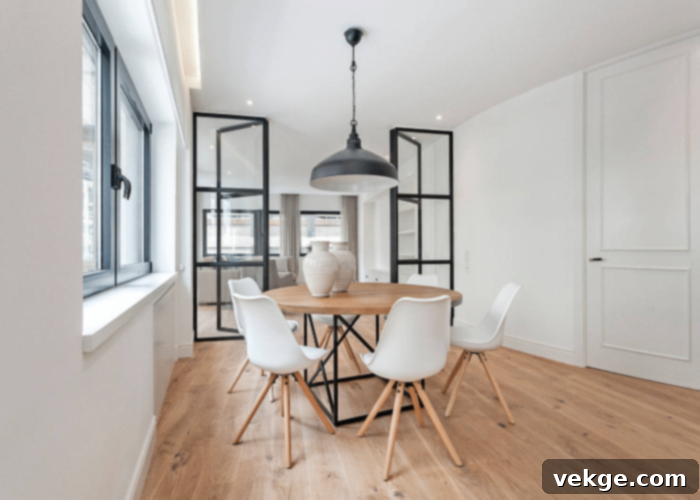
2. Timeless Minimalistic Design
At the core of Scandinavian dining room aesthetics is a strong emphasis on minimalism and decluttering. This philosophy advocates for focusing solely on essentials, ensuring every item serves a purpose or contributes to the overall serene atmosphere. The result is a space that feels uncluttered, open, and visually peaceful. These rooms typically feature a restrained color palette, with white or beige being the most preferred foundational hues, often accented with sophisticated touches of black, deep brown, or soft gold. Furniture designs are characterized by their clean lines, unembellished forms, and often organic or gently geometric shapes. There’s a deliberate avoidance of overly ornate details, ensuring the furniture integrates seamlessly into the minimalist backdrop. Lighting is typically warm and inviting, often achieved through strategically placed fixtures that complement the natural light, preventing the space from feeling stark. This thoughtful design approach, prioritizing simplicity and timeless forms, allows the room to remain stylish and relevant for decades, transcending fleeting trends and offering enduring elegance.
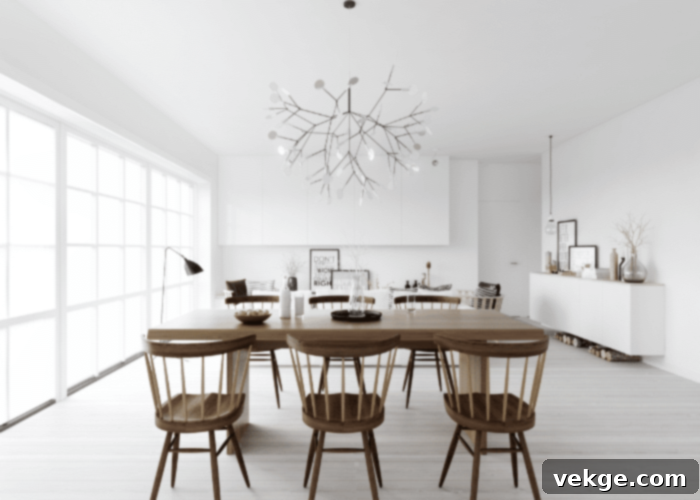
3. Effortless and Accessible Setup
One of the significant advantages of the Scandinavian dining room concept is its straightforwardness in execution. Given its inherently minimalistic design, this style doesn’t demand an exhaustive understanding of complex interior decor principles. There are no intricate rules regarding furniture placement, material pairing, or elaborate color schemes. The emphasis on clean lines, natural materials, and a limited color palette simplifies the decision-making process considerably. This accessibility means that virtually anyone, regardless of their prior experience in home decoration, can successfully implement a Scandinavian dining room. The process typically involves selecting a few key furniture pieces, deciding on a dominant neutral color, and then adding sparse, purposeful decor elements. A quick review of a few inspirational designs is often enough to grasp the core aesthetic and tailor it to your specific space and preferences. This ease of setup reduces stress and makes achieving a beautifully styled dining room an enjoyable, rather than daunting, endeavor.

4. Exceptionally Highly Functional
Despite their minimalist appearance, Scandinavian dining rooms are far from sacrificing quality or utility. In fact, functionality is a cornerstone of this design philosophy. These spaces often feature generously sized dining tables, providing ample surface area not only for a multitude of dishes during meals but also for comfortable seating for family and guests. The robust construction and thoughtful design of Scandinavian furniture ensure durability and longevity. Beyond dining, the inherent simplicity and spaciousness of these rooms allow for versatile use; a large dining table can easily transform into a productive workspace, a creative hub for arts and crafts, or a gathering spot for board games. Every element, from the ergonomic design of a chair to the purposeful placement of a storage unit, is carefully considered. Objects are chosen not merely for their aesthetic appeal but primarily for their practical purpose, contributing to an overall environment that is both beautiful and remarkably efficient, truly making the most of every square inch.

Cons of a Scandinavian Dining Room
While Scandinavian design offers a multitude of benefits, it’s also important to acknowledge potential drawbacks that might influence your decision. Understanding these limitations will help you make an informed choice that best suits your household’s needs and your personal aesthetic preferences.
1. Limited Scope for Personalization
The very strength of Scandinavian dining rooms – their emphasis on minimal and clean designs – can also be perceived as a limitation for some. This aesthetic often leaves less room for bold personal expression through an abundance of decorative items like vibrant paintings, eclectic artworks, or an array of cherished collectibles. While there are no strict rules forbidding personalization, the inherent design philosophy guides towards restraint. Over-personalizing with too many diverse elements can quickly detract from the intended uncluttered and serene ambiance. Homeowners who delight in showcasing a wide variety of personal treasures or prefer a more maximalist approach might find this restriction challenging. However, subtle personalization can still be achieved through carefully selected textiles, a unique ceramic piece, or a singular, impactful artwork, as long as it harmonizes with the overall understated theme. Ultimately, your contentment with the space should dictate your choices, even if it means bending the “rules” slightly.
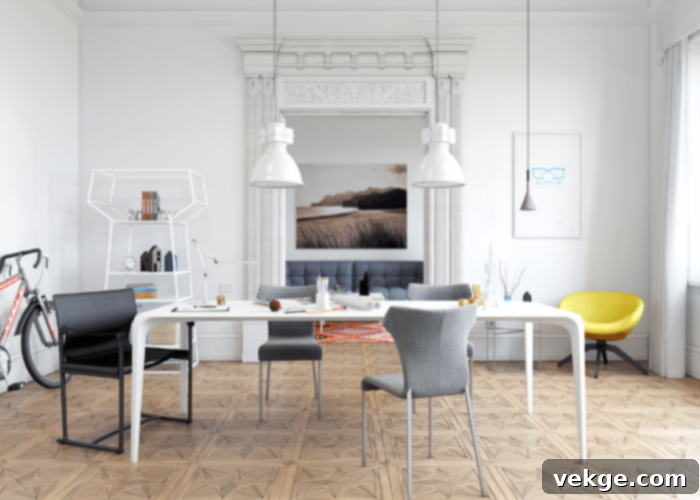
2. Potentially Challenging to Maintain
The clean lines, minimal decor, and predominant use of light, neutral color palettes in Scandinavian dining rooms, while visually appealing, can be surprisingly difficult to maintain. Surfaces and fabrics in shades of white, cream, or light grey are highly susceptible to showing even the smallest stain, smudge, or speck of dirt. This makes the style less ideal for households with young children or active pets, where spills from food, drinks, or art supplies are common occurrences. Maintaining the pristine look often requires a commitment to frequent and diligent cleaning. Wood surfaces, though durable, may also require specific care to prevent scratches or water marks. While the aesthetic is undoubtedly elegant, the practical demands of keeping it immaculate might be a significant consideration for busy families or those who prefer a more relaxed approach to home upkeep.
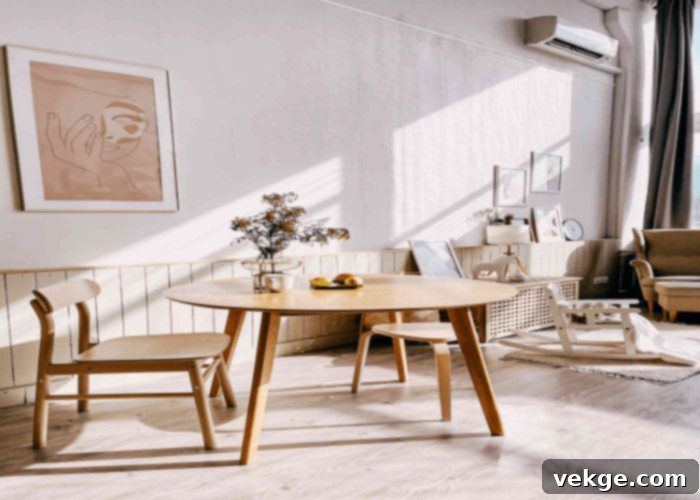
3. Not Universally Appealing
While celebrated by many, the minimalist and understated nature of Scandinavian design is not to everyone’s taste. Some individuals find simple designs to be stark, cold, or even impersonal, believing they lack warmth or character. For those accustomed to rooms filled with rich textures, vibrant colors, or a plethora of decorative items, a Scandinavian dining room might initially feel empty or unfinished. Adapting to a more restrained aesthetic can require a shift in perspective, particularly for those who associate comfort with abundance. Furthermore, the commitment to maintaining a decluttered space can be challenging in the long run. As days turn into weeks and months, the natural accumulation of items can subtly erode the minimalist ideal, potentially undermining the very tranquility the design aims to achieve. This requires consistent effort and discipline to truly embrace the “less is more” philosophy over time, which might go against the inclinations of many homeowners.
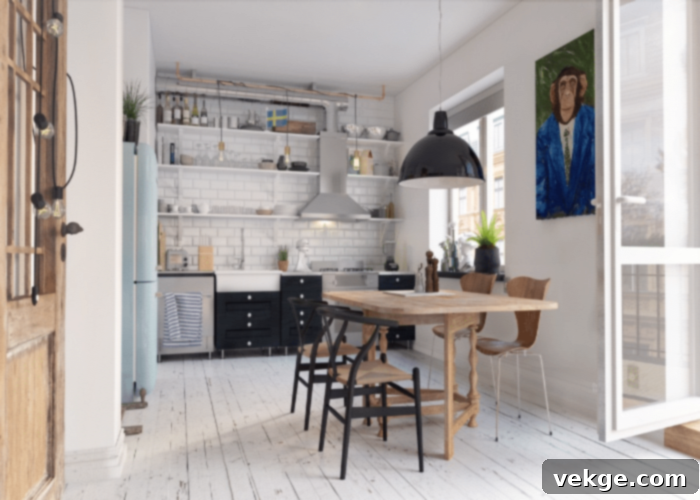
4. Investment in Quality Materials Can Be Costly
A defining characteristic of authentic Scandinavian dining rooms is the use of high-quality, durable furniture crafted from natural materials like solid wood (such as oak, ash, or beech) and sturdy steel. While these materials promise longevity and contribute significantly to the design’s inherent beauty and function, acquiring genuine, well-crafted pieces can be a substantial initial investment. Sustainably sourced natural wood and expertly manufactured minimalist furniture often come with a higher price tag compared to mass-produced alternatives. Finding authentic pieces that meet both aesthetic and quality standards might also require more extensive research and sourcing. However, it’s important to view this as a long-term investment. High-quality Scandinavian furniture is built to last for generations, often becoming timeless heirlooms, thus offering excellent value over time despite the initial cost. This financial consideration is a crucial factor to weigh before committing to this sophisticated dining room style.
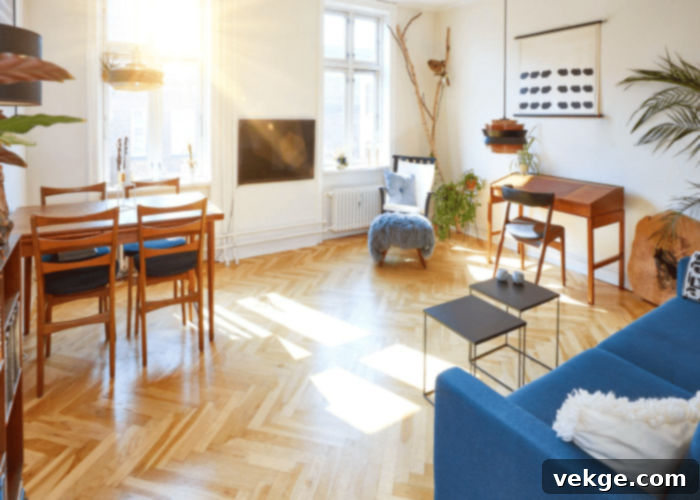
Conclusion
Scandinavian dining rooms stand as a testament to the beauty of thoughtful design, blending elegance with unparalleled functionality. They exude a cozy yet refined ambiance, characterized by their use of large, well-crafted furniture made from natural elements and a commitment to clean, uncluttered aesthetics. This style can transform a dining area into a tranquil and highly adaptable space for both everyday living and special occasions.
However, before fully committing to this popular design philosophy, it’s essential to consider both its compelling advantages and potential drawbacks. The key pros include the ease of setting up such a space, its timeless minimalistic design, exceptional functionality that supports various activities, and the creation of a deeply calming atmosphere. On the flip side, challenges may arise from the potentially expensive initial investment in quality materials, the inherent difficulties in maintaining pristine light-colored surfaces, and the fact that its subdued aesthetic may not resonate with everyone’s personal taste for vibrant or highly personalized decor. Weighing these factors against your lifestyle, budget, and aesthetic preferences will guide you toward making the best decision for your home. We invite you to consider these insights and embark on your journey to create a dining space that truly reflects your ideal of comfort and style.
Scandinavian Dining rooms are elegant and functional. They feel cozy with their large furniture made of natural elements. However, there are some pros and cons that should be considered before deciding on this dining room style.
The pros are that they are easy to set up, minimalistic, highly functional, and a calm space for you to rest. The cons are that the materials may be expensive, it may not suit everyone’s tastes, and it is difficult to maintain. Consider these factors and let us know if you choose a Scandinavian room design!
